Windows
Step 1: Getting started with the installation
Open the folder where you have downloaded the BDRSuite Backup Server setup and run the installer with administrator privileges. It will open the welcome page of the setup wizard, you can begin the installation process by clicking Next.
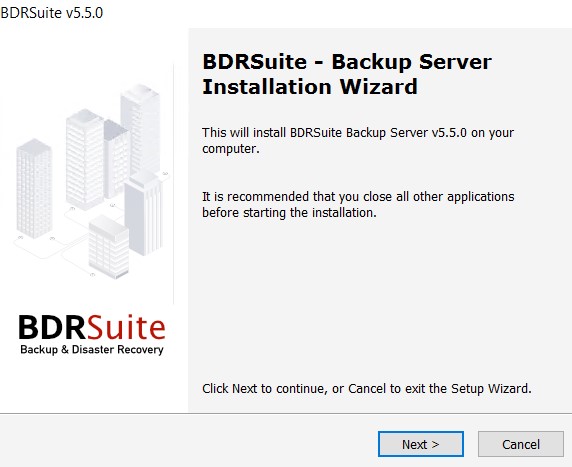
Step 2: License Agreement
'End User License Agreement' is the next step in the installation process. Please read the license agreement carefully as it contains important information about your Rights, Restrictions, Obligations, Limitations, and Exclusions. You must accept the terms in the agreement before continuing with the installation. Select “I accept the terms in the license agreement” and click Next.
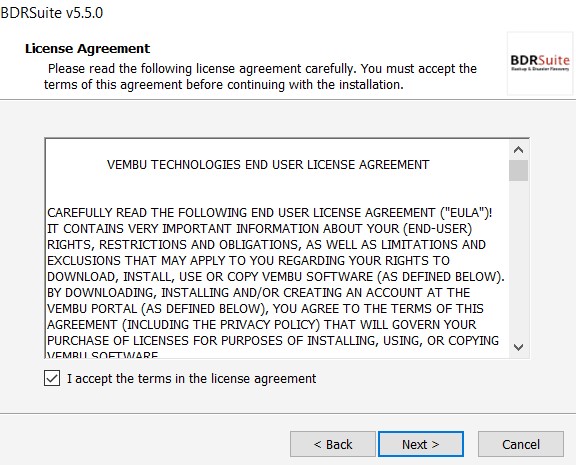
Step 3: Installation Type
The BDRSuite Backup Server can be deployed either as a standalone installation or a Cluster installation.
Step 3a: Cluster Installation
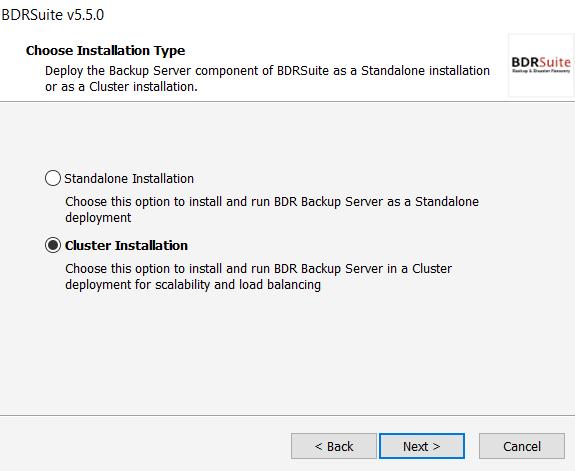
The cluster installation option can be used if you want to install and run the BDRSuite Backup Server in a Cluster Deployment for scalability and load balancing.
This installation type is further classified based on the requirement as follow;
- Main Node with Database
You can select this option to install the BDRSuite Backup Server as well as the Database Components in the same system. This BDRSuite Backup server will act as the Main Node in the cluster while the other BDRSuite Backup Server installations will by default become Sub Nodes in the cluster.
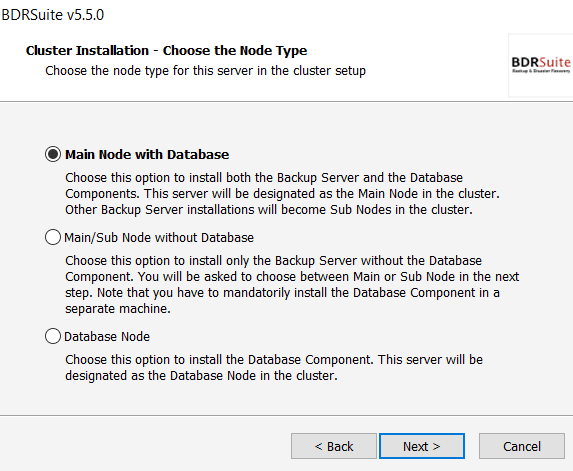
Click next to choose the configuration for the 'Main Node with Database' type of cluster installation.
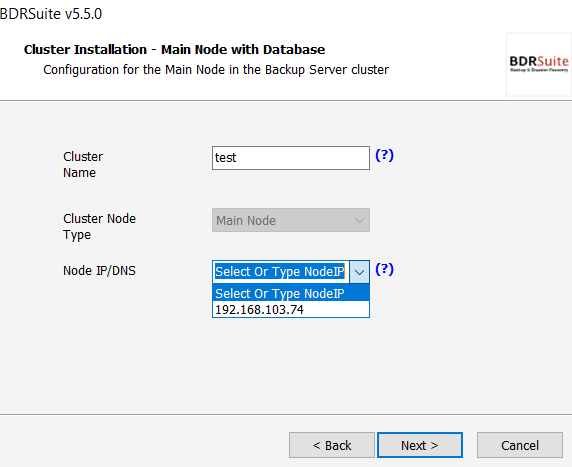
Cluster Name: Enter a unique name identifying the cluster. All nodes will have the same name and will be referred to as the BDR ID of the Server/Cluster.
Cluster Node Type: In this case, it is by default the Main Node.
Node IP/DNS: Select or Type the IP address.
Click next and you will be taken to step 4.
- Main/Sub Node without Database
Choose this option to only Install the BDRSuite Backup Server without the database component.
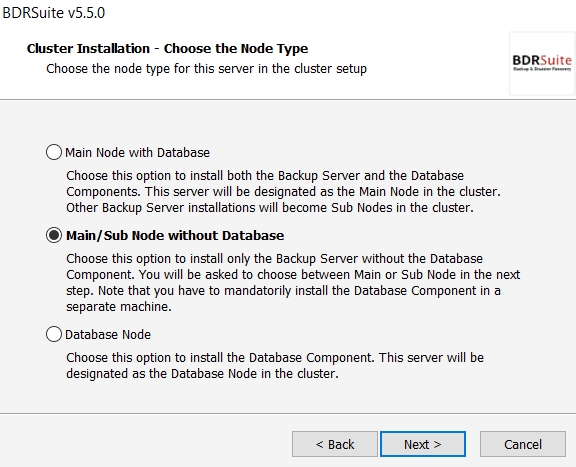
If you have already installed the database then you can optionally test the connectivity between the Main/Sub node and the database here in this step.
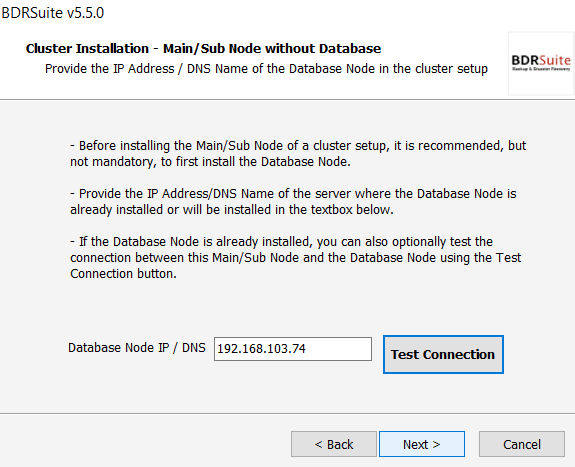
Enter the IP address of the machine where the Database is installed and click on Test Connection.
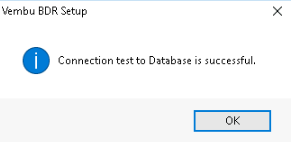
Click next to choose the configuration for the 'Main/Sub Node without Database' type of cluster installation.
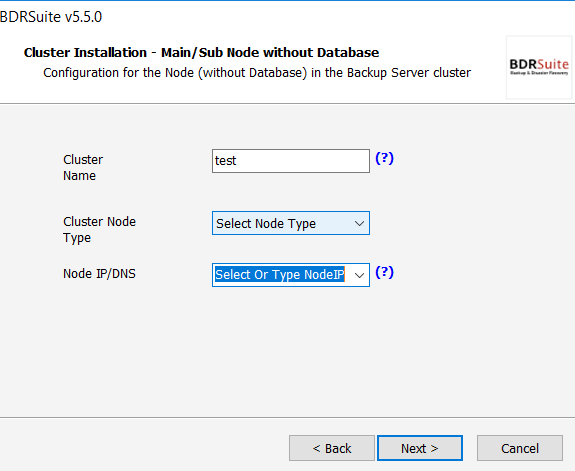
Cluster Name: Enter a unique name identifying the cluster. All nodes will have the same name and will be referred to as the BDR ID of the Server/Cluster.
|
Cluster Node Type: In this case, you can choose either the Main node or the Sub node.
Node IP/DNS: Select or Type the IP address.
Click next and you will be taken to step 4.
- Database Node
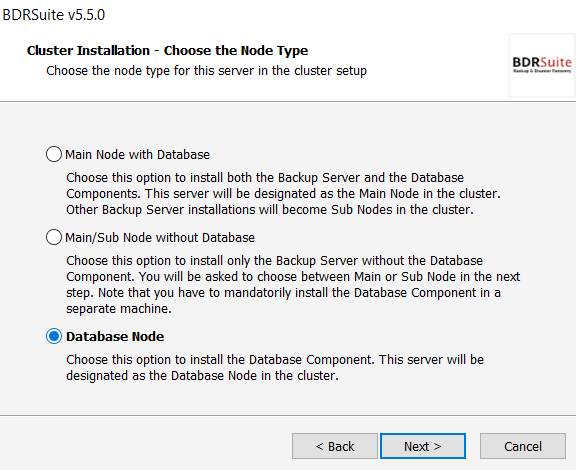
Choose this option to install the Database component alone. This server will be shown as the Database Node in the cluster. Click next and you will be taken to step 4.
Step 4: Installation Directory Customization
The next step in the installation is to specify the folder to install the BDRSuite Backup Server. The installation folder consists of the necessary files to run the application. Make sure you have at least 1.2 GB of free disk space in the installation location.
|
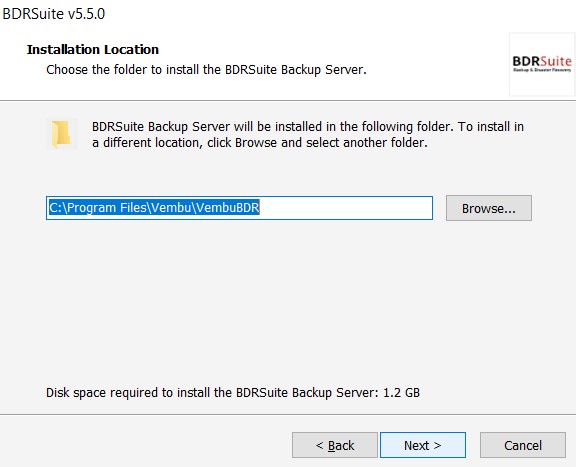
You can leave it to default or click Browse to choose a different folder. You can also create a new folder by clicking on the Make New Folder option and providing a name for the folder. Click Ok to complete the folder creation and click Next to continue with the installation.
|
Step 5: Database Storage Location
BDRSuite Backup Server is using PostgreSQL as the backup database. You need to select the drive to store the database files. By default, it chooses a drive that contains maximum space. However, you can select any one of the available drives as per your requirement.
The database will grow as the backup data grows, so make sure to choose a drive that has a free space of at least 3% of the total size of the backup data. It is strongly recommended not to use an external NAS drive as a DB storage location. It is not recommended to choose OS drive as the database storage location.
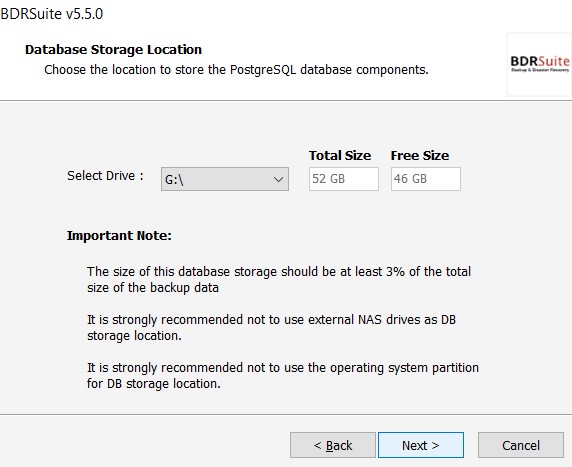
After selecting the database storage location, click Next to proceed with the installation process.
Step 6: Backup Server Settings
You can continue the installation with the default settings or you can customize the settings based on your requirement.
The default settings will be displayed on your installation wizard. If there is no change in the displayed settings, Click Install to begin the installation with default settings.
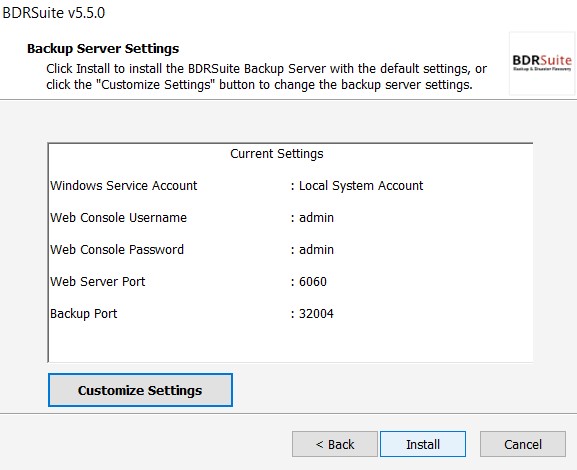
If you want to change any of the default backup server settings, click on the Customize Settings button to modify the default settings.
You can modify the followings backup server settings
- Windows Service Account - Local system or specific user account
- Backup Server web console Login Configuration - Username and password to login to the web console of BDRSuite Backup Server
- Backup Server Port Configuration - Backup port, Web Server port, Secure Web Server port, Internal Service Port
Step 7: Customize Settings - Windows Service Account
In the custom settings, the first step is to specify the Windows logon user account under which the BDRSuite Backup Server service will run. You can select the local system account or a specific user account that has administrator privileges on the computer where BDRSuite Backup Server is being installed.
You need to provide the username and password if you want to install it on any specific account.
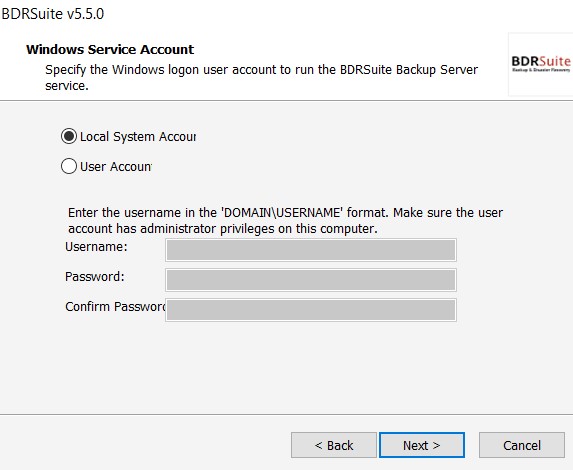
|
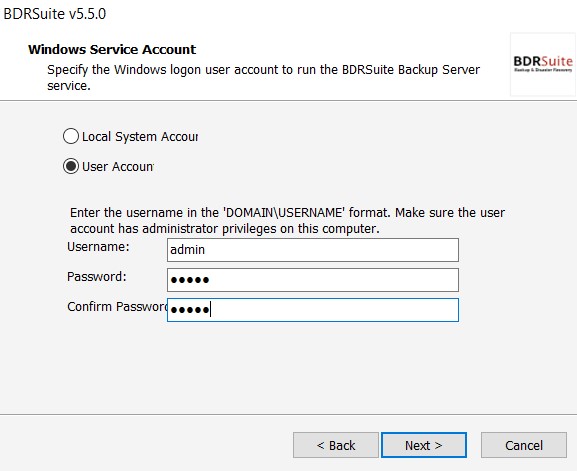
Click Next to continue to the next step.
Step 8: Customize Settings - BDRSuite Backup Server Login Configuration
You can customize the web console login and network ports in this step. Specify the user credentials such as username and password to log in to the web console of the BDRSuite Backup Server. A new user account is created using the given credentials.
The default Username and Password is ‘admin’. You can click on the text box and edit as you require.
You can also specify the Web Server port on this page. It is a port used by the Web Server of BDRSuite Backup Server for the web console. The default port is 6060 and it can be modified. Click on Advanced Port Configurations if you want to change the other network ports.
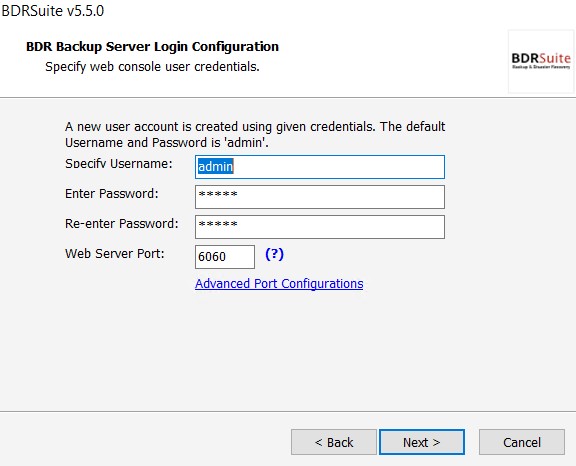
Step 9: Customize Settings - Backup Server Port Configuration
Clicking on Advanced Port Configurations will open a new window that allows you to configure the other network ports such as Backup port, Internal Service Port and, Secure Web Server port. You can edit and configure these network ports as per your requirements.
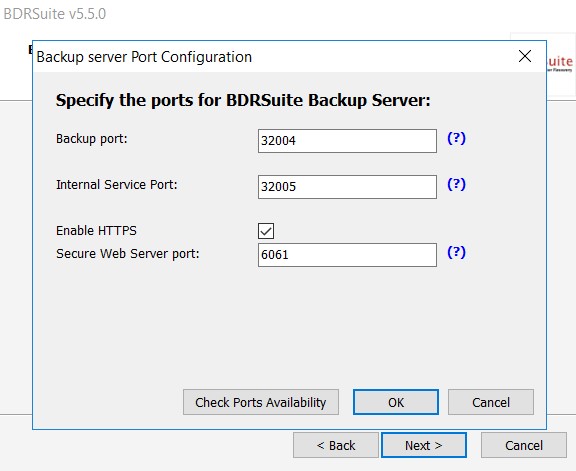
Secure WebServer port: The Port used by the Web Server of BDRSuite Backup Server for secure connections. The default port is 6061.
Backup port: The port used by BDRSuite Backup Server to transfer the backup data. The default port is 32004.
Internal Service Port: The port used for internal module communications. The default port is 32005.
After making changes to the port, you can check the availability of the entered ports by clicking on the Check Ports Availability button. If entered ports are not available, you can edit the ports and check for availability again.
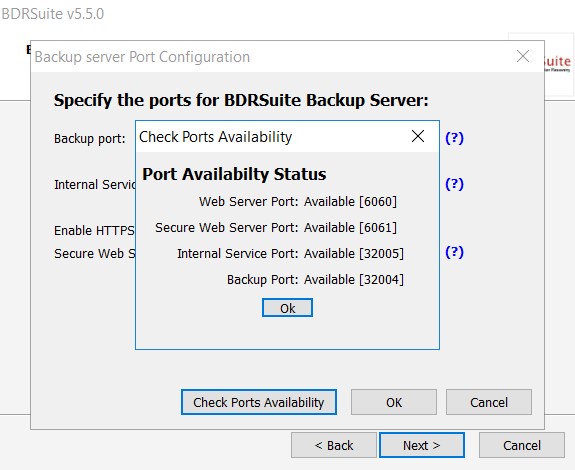
Click Ok to confirm the port selection and Click Next on the Backup Server Port Configuration window to proceed further.
Step 10: Review Settings
Review all the settings you have selected for the installation. If you want to change any of the backup server settings, you can click Back and change it. If there are no changes, click Install to begin the installation of the BDRSuite Backup Server.
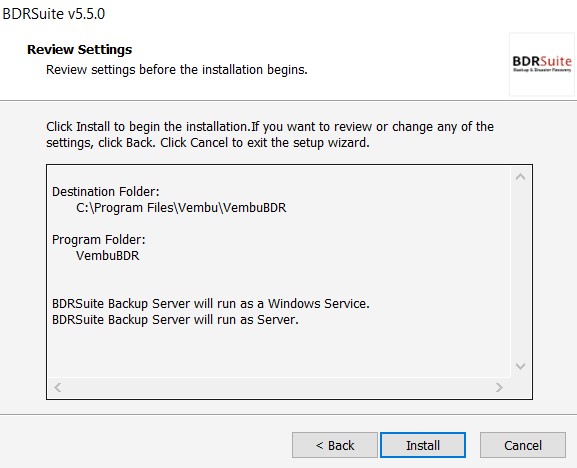
Step 11: Installing the necessary components
The setup wizard will start to install the BDRSuite Backup Server v5.2.0 on your computer. The following components are installed in your machine during this installation process;
- PostgreSQL
- ODBC drivers (32-bit and 64-bit)
- Web Server
- BDRSuite Backup Server
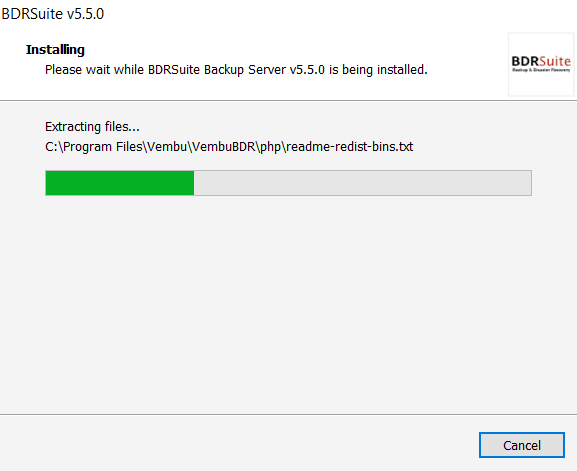
Step 12: Completing Installation
The BDRSuite Backup Server and its components are successfully installed on your computer. If you would like to start the application immediately or open the web console, you can do it by selecting the checkboxes given in the setup wizard
After selecting the appropriate option, click Finish to complete the installation process.

Step 13: Changing the service account(optional)
By default, BDRSuiteServer will be installed as a service and run under the local system account. So we recommend providing administrative privileges via Services.msc:
- Navigate to services.msc and right-click over the service "BDR" and click Properties
- Click Log On tab and provide administrator account details
- This will allow BDRSuiteServer to run with administrative privileges
